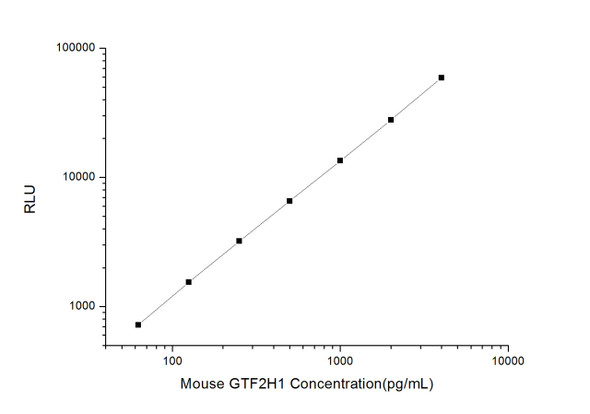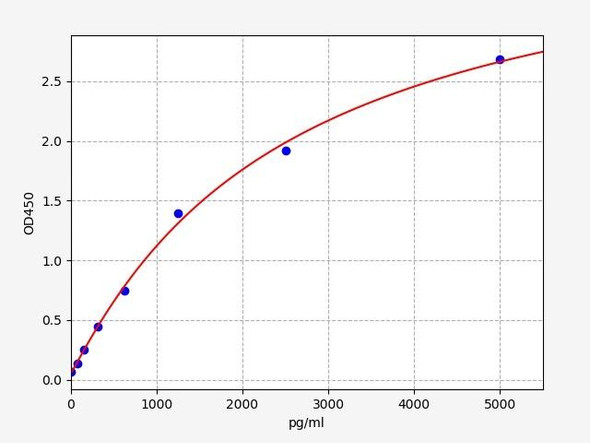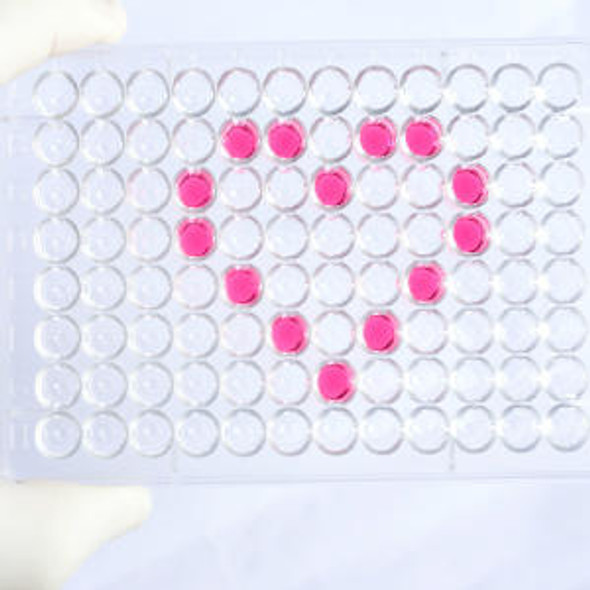Human Epigenetics and Nuclear Signaling ELISA Kits
Human GTF2A1 (General Transcription Factor IIA, Polypeptide 1) CLIA Kit (HUES00288)
- SKU:
- HUES00288
- Product Type:
- ELISA Kit
- ELISA Type:
- CLIA Kit
- Size:
- 96 Assays
- Sensitivity:
- 46.88pg/mL
- Range:
- 78.13-5000pg/mL
- ELISA Type:
- Sandwich
- Synonyms:
- TF2A1, TFIIA, TFIIA-42, TFIIAL
- Reactivity:
- Human
- Sample Type:
- Serum, plasma and other biological fluids
- Research Area:
- Epigenetics and Nuclear Signaling
Description
| Assay type: | Sandwich |
| Format: | 96T |
| Assay time: | 4.5h |
| Reactivity: | Human |
| Detection method: | Chemiluminescence |
| Detection range: | 78.13-5000 pg/mL |
| Sensitivity: | 46.88 pg/mL |
| Sample volume: | 100µL |
| Sample type: | Serum, plasma and other biological fluids |
| Repeatability: | CV < 15% |
| Specificity: | This kit recognizes Human GTF2A1 in samples. No significant cross-reactivity or interference between Human GTF2A1 and analogues was observed. |
This kit uses Sandwich-CLIA as the method. The micro CLIA plate provided in this kit has been pre-coated with an antibody specific to Human GTF2A1. Standards or samples are added to the appropriate micro CLIA plate wells and combined with the specific antibody. Then a biotinylated detection antibody specific for Human GTF2A1 and Avidin-Horseradish Peroxidase (HRP) conjugate are added to each micro plate well successively and incubated. Free components are washed away. The substrate solution is added to each well. Only those wells that contain Human GTF2A1, biotinylated detection antibody and Avidin-HRP conjugate will appear fluorescence. The Relative light unit (RLU) value is measured spectrophotometrically by the Chemiluminescence immunoassay analyzer. The RLU value is positively associated with the concentration of Human GTF2A1. The concentration of Human GTF2A1 in the samples can be calculated by comparing the RLU of the samples to the standard curve.
| UniProt Protein Function: | GTF2A1: a general transcription factor that plays an important role in transcriptional activation. A component of the transcription machinery of RNA polymerase II. Phosphorylated by Taf(II) 250 on serines that regulate TBP binding. Interacts with TBP (the TATA-binding protein). Two isoforms, 42 kDa and 37 kDa, are produced by alternative initiation. |
| UniProt Protein Details: | Protein type:Transcription, coactivator/corepressor Chromosomal Location of Human Ortholog: 14q31. 1 Cellular Component: cytoplasm; nucleoplasm; transcription factor TFIIA complex Molecular Function:DNA binding; protein binding; protein heterodimerization activity; TATA-binding protein binding; transcription coactivator activity; transcription factor binding Biological Process: RNA elongation from RNA polymerase II promoter; snRNA transcription from RNA polymerase II promoter; transcription from RNA polymerase II promoter; transcription initiation from RNA polymerase II promoter |
| NCBI Summary: | Accurate transcription initiation on TATA-containing class II genes involves the ordered assembly of RNA polymerase II (POLR2A; MIM 180660) and several general initiation factors (summarized by DeJong and Roeder, 1993 [PubMed 8224848]). One of these factors is TFIIA, which when purified from HeLa extracts consists of 35-, 19-, and 12-kD subunits. [supplied by OMIM, Jul 2010] |
| UniProt Code: | P52655 |
| NCBI GenInfo Identifier: | 1711663 |
| NCBI Gene ID: | 2957 |
| NCBI Accession: | P52655. 1 |
| UniProt Secondary Accession: | P52655,Q3KNQ9, |
| UniProt Related Accession: | P52655 |
| Molecular Weight: | 37,152 Da |
| NCBI Full Name: | Transcription initiation factor IIA subunit 1 |
| NCBI Synonym Full Names: | general transcription factor IIA subunit 1 |
| NCBI Official Symbol: | GTF2A1 |
| NCBI Official Synonym Symbols: | TF2A1; TFIIA; TFIIAL; TFIIA-42 |
| NCBI Protein Information: | transcription initiation factor IIA subunit 1 |
| UniProt Protein Name: | Transcription initiation factor IIA subunit 1 |
| UniProt Synonym Protein Names: | General transcription factor IIA subunit 1; TFIIAL; Transcription initiation factor TFIIA 42 kDa subunit; TFIIA-42 |
| Protein Family: | Transcription initiation factor |
| UniProt Gene Name: | GTF2A1 |
| UniProt Entry Name: | TF2AA_HUMAN |
As the RLU values of the standard curve may vary according to the conditions of the actual assay performance (e. g. operator, pipetting technique, washing technique or temperature effects), the operator should establish a standard curve for each test. Typical standard curve and data is provided below for reference only.
| Concentration (pg/mL) | RLU | Average | Corrected |
| 5000 | 61146 61366 | 61256 | 61233 |
| 2500 | 31364 37344 | 34354 | 34331 |
| 1250 | 18814 17524 | 18169 | 18146 |
| 625 | 8696 10088 | 9392 | 9369 |
| 312.5 | 5049 4617 | 4833 | 4810 |
| 156.25 | 2682 2340 | 2511 | 2488 |
| 78.13 | 1258 1420 | 1339 | 1316 |
| 0 | 22 24 | 23 | -- |
Precision
Intra-assay Precision (Precision within an assay): 3 samples with low, mid range and high level Human GTF2A1 were tested 20 times on one plate, respectively.
Inter-assay Precision (Precision between assays): 3 samples with low, mid range and high level Human GTF2A1 were tested on 3 different plates, 20 replicates in each plate.
| Intra-assay Precision | Inter-assay Precision | |||||
| Sample | 1 | 2 | 3 | 1 | 2 | 3 |
| n | 20 | 20 | 20 | 20 | 20 | 20 |
| Mean (pg/mL) | 276.73 | 541.51 | 2290.84 | 294.81 | 591.43 | 2151.34 |
| Standard deviation | 26.73 | 54.58 | 175.48 | 36.26 | 43.06 | 212.98 |
| C V (%) | 9.66 | 10.08 | 7.66 | 12.30 | 7.28 | 9.90 |
Recovery
The recovery of Human GTF2A1 spiked at three different levels in samples throughout the range of the assay was evaluated in various matrices.
| Sample Type | Range (%) | Average Recovery (%) |
| Serum (n=5) | 91-105 | 97 |
| EDTA plasma (n=5) | 99-119 | 108 |
| Cell culture media (n=5) | 97-111 | 105 |
Linearity
Samples were spiked with high concentrations of Human GTF2A1 and diluted with Reference Standard & Sample Diluent to produce samples with values within the range of the assay.
| Serum (n=5) | EDTA plasma (n=5) | Cell culture media (n=5) | ||
| 1:2 | Range (%) | 95-109 | 93-106 | 88-101 |
| Average (%) | 101 | 100 | 94 | |
| 1:4 | Range (%) | 95-110 | 92-104 | 101-117 |
| Average (%) | 102 | 98 | 108 | |
| 1:8 | Range (%) | 99-111 | 102-118 | 99-109 |
| Average (%) | 104 | 109 | 104 | |
| 1:16 | Range (%) | 102-116 | 90-105 | 89-99 |
| Average (%) | 108 | 96 | 94 |
An unopened kit can be stored at 4°C for 1 month. If the kit is not used within 1 month, store the items separately according to the following conditions once the kit is received.
| Item | Specifications | Storage |
| Micro CLIA Plate(Dismountable) | 8 wells ×12 strips | -20°C, 6 months |
| Reference Standard | 2 vials | |
| Concentrated Biotinylated Detection Ab (100×) | 1 vial, 120 µL | |
| Concentrated HRP Conjugate (100×) | 1 vial, 120 µL | -20°C(shading light), 6 months |
| Reference Standard & Sample Diluent | 1 vial, 20 mL | 4°C, 6 months |
| Biotinylated Detection Ab Diluent | 1 vial, 14 mL | |
| HRP Conjugate Diluent | 1 vial, 14 mL | |
| Concentrated Wash Buffer (25×) | 1 vial, 30 mL | |
| Substrate Reagent A | 1 vial, 5 mL | 4°C (shading light) |
| Substrate Reagent B | 1 vial, 5 mL | 4°C (shading light) |
| Plate Sealer | 5 pieces | |
| Product Description | 1 copy | |
| Certificate of Analysis | 1 copy |
- Set standard, test sample and control (zero) wells on the pre-coated plate and record theirpositions. It is recommended to measure each standard and sample in duplicate. Note: addall solutions to the bottom of the plate wells while avoiding contact with the well walls. Ensuresolutions do not foam when adding to the wells.
- Aliquot 100µl of standard solutions into the standard wells.
- Add 100µl of Sample / Standard dilution buffer into the control (zero) well.
- Add 100µl of properly diluted sample (serum, plasma, tissue homogenates and otherbiological fluids. ) into test sample wells.
- Cover the plate with the sealer provided in the kit and incubate for 90 min at 37°C.
- Aspirate the liquid from each well, do not wash. Immediately add 100µL of BiotinylatedDetection Ab working solution to each well. Cover the plate with a plate seal and gently mix. Incubate for 1 hour at 37°C.
- Aspirate or decant the solution from the plate and add 350µL of wash buffer to each welland incubate for 1-2 minutes at room temperature. Aspirate the solution from each well andclap the plate on absorbent filter paper to dry. Repeat this process 3 times. Note: a microplatewasher can be used in this step and other wash steps.
- Add 100µL of HRP Conjugate working solution to each well. Cover with a plate seal andincubate for 30 min at 37°C.
- Aspirate or decant the solution from each well. Repeat the wash process for five times asconducted in step 7.
- Add 100µL of Substrate mixture solution to each well. Cover with a new plate seal andincubate for no more than 5 min at 37°C. Protect the plate from light.
- Determine the RLU value of each well immediately.






